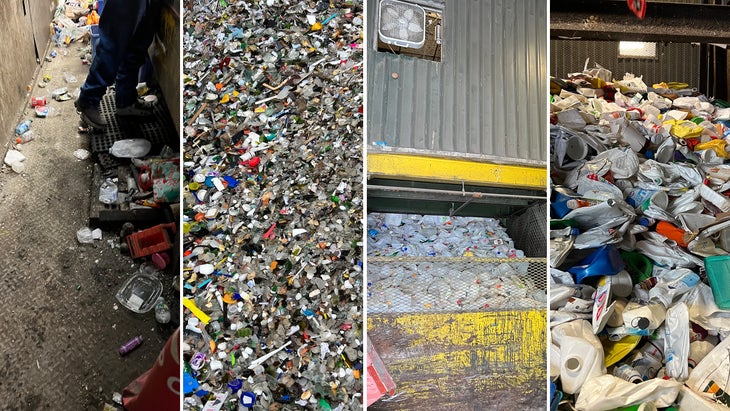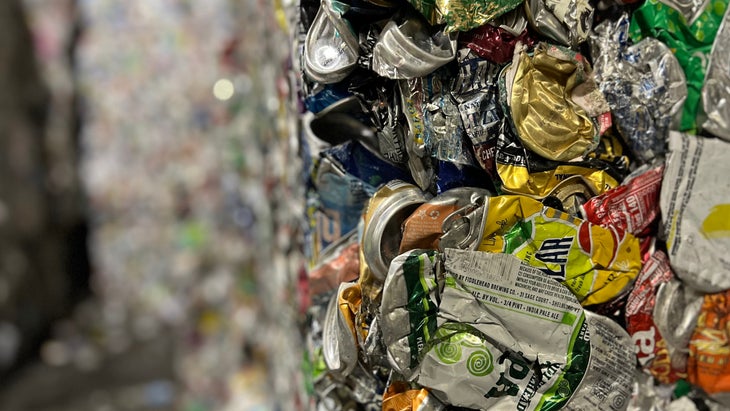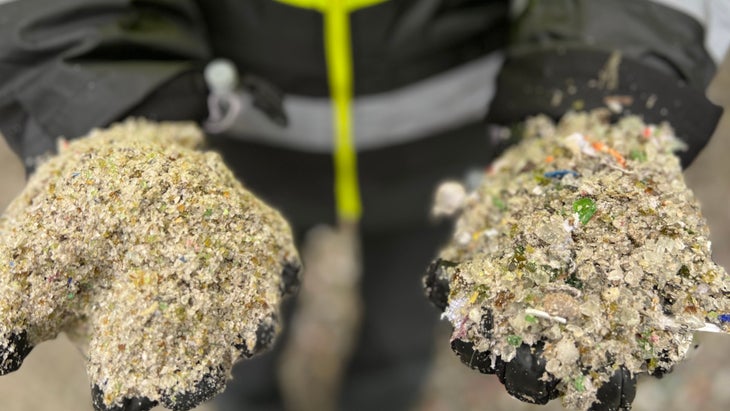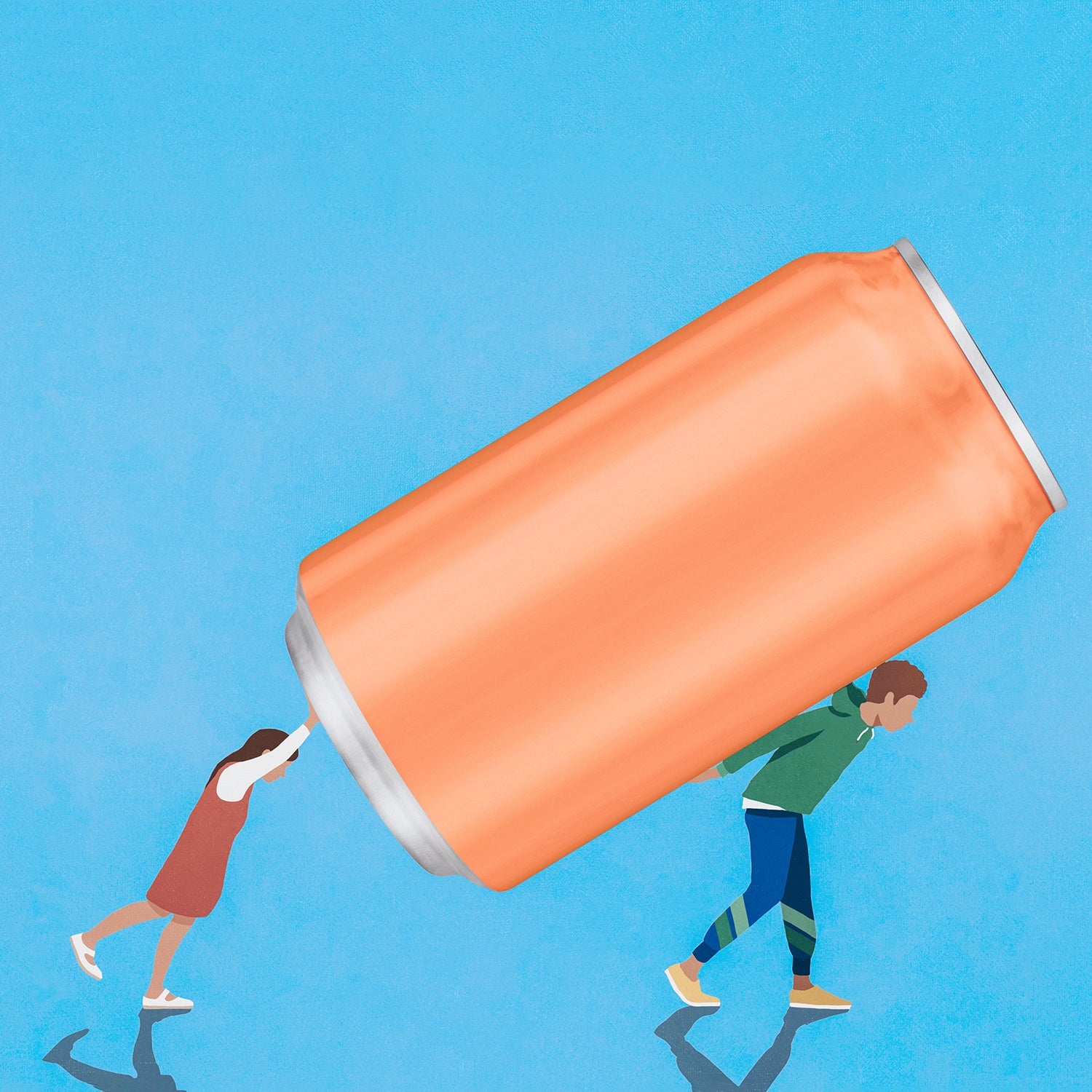Ever wonder what happens to the yogurt cups, beer cans, and junk mail we so casually toss in our recycle bins every day? Where does the big green truck go when it rumbles away from our curb? For me, it’s out of sight, out of mind and every Thursday morning when I drag my green bin to the curb, I always feel a little righteous, knowing that I’m doing my part to keep the planet clean.
But am I? Where do my empty cans of coconut milk and tomato paste actually go and what happens to them? And does everything in my bin magically transform into new useful objects that the world needs?
I decided to find out. I called my friend Michelle Morris, who heads up marketing for the (CSWD) in northern Vermont. CSWD runs a Materials Recycling Facility (called a MRF, which rhymes with “surf”) about 30 minutes from my home in Stowe, and Morris agreed to give me a tour.
MRFs are located all over the country. They’re where all your single-stream curbside recycling goes for sorting and baling being sold and shipped off to processing plants that turn those items into new materials. A crucial cog in the recycling process, MRFs are loud, dirty, smelly hangars. Scraps of rubbish litter the floor and blow around. Mountains of recyclable items spill out from sorting corrals—metal, paper, cardboard, glass, and various iterations of plastic. So much plastic.
Inside, gears grind, machines roar, fans blast, and the beep-beep-beep of forklifts and loaders buzz about. The air is thick with the aroma of sour milk and rotting food. In the center of the vast warehouse lies a monstrous Rube Goldberg machine which shuttles refuse along a series of stations designed to group similar recyclables together and weed out non-recyclable trash so it doesn’t contaminate the batch. It’s a semi-mechanical system that requires hands-on help from the many helmet-, goggle-, glove-wearing workers stationed along the assembly lines. They’re trained to quickly scan the stuff whizzing by on conveyor belts and pluck out what doesn’t belong.
Recycling in Action
I stood for a while, mesmerized, watching the endless flow of what looked like nasty crap and thought about all the wrong recycling moves I’ve made in the past. But when recycling’s done right—and the system works—that gross junk is a valuable commodity that gets turned into useful stuff.
While our recycling systems are far from perfect, they are better than not recycling at all and relying on materials extracted directly from nature. Circularity, specifically in packaging, is the holy grail of recycling.
Of course, not every item can be recycled forever. Jackie Nuñez of told me that plastics, for example, cannot. “Some materials—including paper, glass, and aluminum—can be recycled infinitely to extend their useful lives.” Many of the valuable precious metals in electronics is also indefinitely recyclable. “Separating and recycling these materials can reduce energy and water consumption, and extraction from the Earth compared to new manufacturing.”

Nuñez stresses the importance of the “three Rs” that come before recycling: refuse, reduce, and reuse. “While recycling may be better than wasting materials, it should not be our first-choice option to address wastefulness,” she says. “Recycling also drives serious pollution and injustice, particularly in front- and fence-line communities, where the materials are being processed. As we reduce and reuse materials, we must urgently improve and reduce harm caused by recycling systems.”
Our individual behaviors can have a direct impact on how well recycling systems actually function. After watching the staff at CSWD sort through the tons of stuff we send their way, I understood how a recycling system could easily go haywire if people are careless with the items they place in curbside bins. After my tour of the facilities, I sat down with Morris and asked for her tips—the dos and don’ts—on how we can support the recycling system with our daily habits. Remember: these tips are a mere guideline. Rules can vary by facility, so be sure to stay informed about what flies and what doesn’t in your community. And when in doubt, give a shout (to your local collector).
15 Recycling Dos and Don’ts
DO keep plastic caps attached to their bottles.
Bottle caps are among the top 5 items found during beach cleanups, . They’re too small to get properly sorted at the recycling facility so they literally fall through the cracks and end up at the landfill. Keep all caps attached to their plastic bottles for the best recycling rate.
DON’T crush aluminum cans.
Flat cans act like paper in the sorting system and can end up in the paper pile/bales by mistake.

DON’T put your recyclables in a plastic garbage bag.
Workers won’t open and sort bags. They’ll just toss them into the dumpster headed for the landfill. Save the garbage bags for garbage.
DO recycle pizza boxes.
But first remove and either compost or trash any sections with grease stains or stuck on cheese.
DON’T recycle SOLO cups, red or otherwise.
Chances are, your recycler doesn’t take the #5 and #6 plastics they’re made of. Better yet, avoid single-use drinkware. Try these instead.
DO recycle tin foil.
Just make sure it isn’t caked with lasagna. Try and collect enough to make a ball that’s at least three inches in diameter, so it won’t fall through the machinery cracks.
DON’T recycle coffee cups, juice boxes, ice cream cartons, frozen food boxes.
Though they look like paper or cardboard, they have a plastic lining that, in many cases, means they are not recyclable. Check with your local recycler to verify.

DO keep your paper and cardboard dry.
A few drops of rain are no problem but the recycling systems work best with dry materials.
DON’T recycle any black plastic.
Even if it has the little arrows on it, there is . Avoid it (by bringing your own container to the restaurant), and if you can’t, trash it.
DO flatten your cardboard boxes.
“Un-flattened boxes take up stupid amounts of space in trucks and can cause bridging in roll-off and truck compactors, which can back up other materials and prevent loads from being compacted,” says Morris. “That means more emissions due to inefficient use of space and more trips. If they make it to the MRF un-flattened, the machinery can’t sort them properly.”
DON’T attempt to recycle anything labeled “compostable.”
Composting is a separate stream altogether, and it can contaminate recyclables.
DO rinse out containers.
Copious amounts of peanut butter or ketchup is gross and dangerous for workers and can devalue the material of the container. A quick rinse is all that’s needed.
DON’T recycle plastic straws.
They’re too lightweight to make it through the sorting machinery, so they end up dropping the floor and getting swept off to the landfill. Just say no to straws—use your lips!
DON’T recycle light bulbs.
Most of them contain mercury so should be handled as hazardous waste. Contact your town for the nearest drop off.
Doing right by the planet can make you happier, healthier, and—yes—wealthier. �����ԹϺ���’s head of sustainability, Kristin Hostetter, explores small lifestyle tweaks that can make a big impact. Write to her at climateneutral-ish@outsideinc.com.


